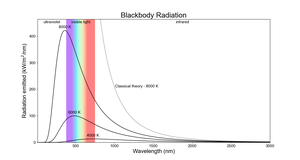Glossary term: इलेक्ट्रोमॅग्नेटिक रेडिएशन (विद्युतचुंबकीय विकिरण)
Description: जब १९वीं सदी के भौतिकविदों ने विद्युत और चुंबकीय घटनाओं का वर्णन किया, तो उन्होंने पाया कि विद्युत और चुंबकीय प्रभाव के पैटर्न प्रकाश की गति से अंतरिक्ष में यात्रा करने का तरीका थे, यहां तक कि उन स्थितियों में भी जहां लगभग कोई विद्युत चार्ज नहीं है। इन तरंगों को विद्युत चुम्बकीय तरंगें या विद्युत चुम्बकीय विकिरण कहा जाता है। प्राथमिक विद्युत चुम्बकीय तरंगों को उनकी तरंग दैर्ध्य के अनुसार वर्गीकृत किया जा सकता है, और परिणामी विद्युत चुम्बकीय स्पेक्ट्रम में छोटी से लंबी तरंग दैर्ध्य गामा किरणें, एक्स-रे, पराबैंगनी, दृश्य प्रकाश, अवरक्त, सबमिलिमीटर, मिलीमीटर/माइक्रोवेव और रेडियो तरंगें शामिल हैं। दूर स्थित खगोलीय पिंडों से निकलने वाला विद्युतचुंबकीय विकिरण खगोलविदों के लिए ऐसी पिंडों के बारे में जानकारी का सबसे महत्वपूर्ण स्रोत है।
Related Terms:
- विद्युत चुम्बकीय बल
- Gamma Ray
- Infrared (IR)
- Light
- Microwave Radiation
- Ultraviolet
- Visible Spectrum
- Submillimeter Astronomy
- X-ray
See this term in other languages
Term and definition status: The original definition of this term in English have been approved by a research astronomer and a teacher The translation of this term and its definition is still awaiting approval
The OAE Multilingual Glossary is a project of the IAU Office of Astronomy for Education (OAE) in collaboration with the IAU Office of Astronomy Outreach (OAO). The terms and definitions were chosen, written and reviewed by a collective effort from the OAE, the OAE Centers and Nodes, the OAE National Astronomy Education Coordinators (NAECs) and other volunteers. You can find a full list of credits here. All glossary terms and their definitions are released under a Creative Commons CC BY-4.0 license and should be credited to "IAU OAE".
If you notice a factual or translation error in this glossary term or definition then please get in touch.
Related Diagrams
Blackbody Radiation
Credit: IAU OAE/Niall Deacon
License: CC-BY-4.0 Creative Commons Attribution 4.0 International (CC BY 4.0) icons
Blackbody Radiation - UV Catastrophe
Credit: IAU OAE/Niall Deacon
License: CC-BY-4.0 Creative Commons Attribution 4.0 International (CC BY 4.0) icons










